1
En lille familie, far, mor og en sovende datter bliver fuldstændigt uvarslet hentet en tidlig sommermorgen. Det er i Estland, det er ude på landet, æbletræerne blomstrer og duften er overvældende dejlig. Ingen forstår det hele omfang af det som sker. Min helt store oplevelse på Baltic Frames søndag var denne film, dette vældige værk, denne rige film som i mine associationer undervejs rammer Bergman-erindringer fra både Smultronstället og Skammen og Tarkovskij-erindringer fra Spejlet og senest rammer filmen umistelige Guzmán-indtryk fra Lysets nostalgi og dertil min egen helt personlige nutidige angst for med ét ikke længere at være beskyttet af mit land og min regering, ladt alene med min angst for bankene på døren en tidlig morgen, min angst for deportation, mishandling og forsvinding.
2
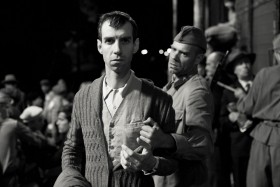
På jernbanestationen skilles familien. Manden skal blive, han skal et andet sted hen, moderen og barnet skal med toget, hvorhen ved de ikke. Jeg ved det jo, ved hvor begge skal hen, jeg sidder med min gamle viden om det tyvende århundredes historie, om dette nye århundredes, min samtids begivenheder. Afskeden på perronen er som scene mytologisk i århundredets ikonografi og elegi.
3
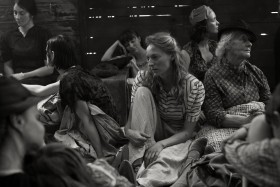
Jeg ved at kvinderne og børnene i godsvognen er på den dagelange rejse til arbejdslejren i Sibirien. Filmens dagbogsfortælling gemt i kvindens breve har imidlertid ikke den viden, og den indeholder endnu håbet om den mærkelige misforståelse. Årene er 1940-ernes første, Letland er en del af det store velordnede Sovjetunionen. Jeg ved nu så længe efter, at den velordnethed bygger på en omfattende undertrykkelse af efterhånden den mindste afvigelse, ved det også fra de baltiske landes film de seneste årtier. Husker med ét tydeligt lettiske Andris Rozenbergs’ Punished for a Dream (1994) hvor Elza Sterste skriver sine breve fra lejren i Sibirien som digte: ”Kroppen har ikke længere vægt, sjælen har ingen grænse. Jeg skaber mig selv af lys og ånd. Og når lyset svinder i dette lands tusmørke, letter jeg som en fjer.”
4
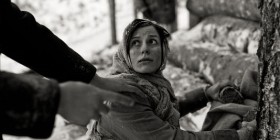
Rationen er 200 gram brød om dagen. Til de arbejdende voksne. Til børnene ingenting. Moderen finder ud af hvor brødrationerne opbevares. Vil tage lidt mere til sit barn. Opdages. Må tage imod en invitation til at drikke vodka med lejrchefen, være sammen med ham. Brevet til hendes mand, hvor hun fortvivlet forklarer og beder om tilgivelse, et brev som han jo aldrig får, hører jeg læst med denne rolige, smukke stemme. Gribes så dybt.
5
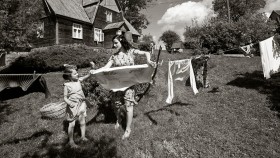
Det som holder de sibiriske nætter og dage også og ind imellem fjerlet fri af ydmygelserne, smerterne, sulten og udmattelsen er nedskrivningerne af brevenes sansninger af hændelser, oplevelser, datterens liv, længsler, af kærlighedens forvandlingsformer og erindringen om hjemmet i det lettiske landskab, altid sommer og duften af en blomstrende gren og lykken under æbletræets hvide dække.
6
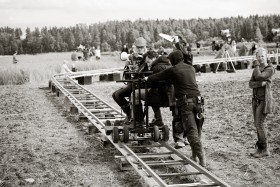
Filmen står tilbage i erindringen som et diskret, nænsomt og dog omhyggeligt altseende kameras ustandseligt bevægede skildring af en lidelseshistorie bevaret i en række tableauer fra en tid som var men ikke er, tableauer over kvindens journal, hendes aldrig sendte / aldrig modtagne breve til sin mand, sin elskede, en forunderligt sammenhængende tekst samtidig så smukt læst, jeg ønskede hele tiden jeg forstod estisk, en tekst musikalsk prægnant helt ned i den engelske litterære oversættelse.
Martti Helde: In The Crosswind, Estland 2014 87 min.
SYNOPSIS
On the night of June 14, 1941, many thousands of inhabitants of Latvia, Lithuania, and Estonia — identified as “anti-Soviet elements” by the USSR, which had annexed the Baltic states the previous year — were forced onto trains and sent to the remotest outposts of Siberia. Thousands of families were torn apart and forced to endure brutal conditions for nearly two decades until their eventual release. Inspired by a first-hand account of these events, this unforgettable debut feature by director Martti Helde meticulously reconstructs one survivor’s story to create a delicate, powerfully moving memorial to all the victims of this massive and often-overlooked tragedy.
In the Crosswind focuses on the personal experience of philosophy student Erna (ed.: Erna Nagel) (Laura Peterson) as she endures physical and psychological hardships alongside her little daughter, Eliide, while waiting to be reunited with her husband Heldur, a soldier. Drawing from the diary kept by the real-life Erna throughout her displacement, Helde renders her memories in striking black-and-white tableaux vivants. Carving out an uncanny space between motion and stasis, these images evoke a state in which the past seems solid and the present like a dream.
Exhaustively researched, with immersive sound design and sumptuous cinematography, In the Crosswind is a remarkable achievement: a testimony to a vital historical moment, a powerfully subjective account of a search for home, and an ode to the ethereal strangeness of memory. (Dimittri Eipides, tiff.net)
LITTERATUR / LINKS
https://www.youtube.com/watch?v=G6q1OWCxxpQ (trailer)
tiff.net (om filmen, credits mv.)
http://www.off-kino.dk/introduktion.html (dansk importør)
dr.dk/kultur/nyheder/ (Per Juul Carlsens grundige anmeldelse, hvor han også nøgternt beskriver filmens overraskende æstetiske og tekniske løsninger)
Tue Steen Müller, red.: Balticum Film & TV Festival 1990-99, Baltic Media Centre, 1999, ENGLISH. (Essays om blandt andre Mark Soosaar, Herz Frank, Audrius Stonys, Juris Podnieks, Andris Slapins)







